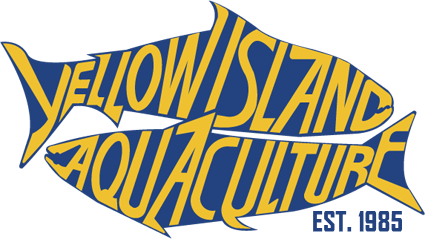

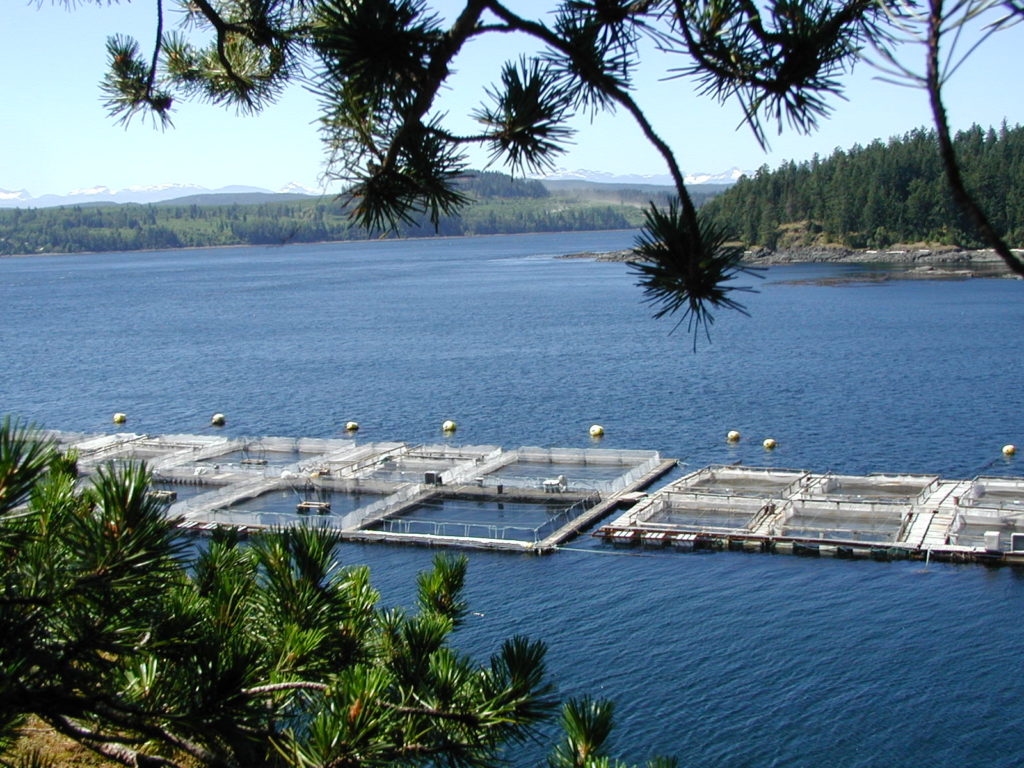
Our saltwater grow out site at Yellow Island Aquaculture offers ideal conditions for the growth and propagation of salmon. Salmon require cold water for optimal health and the Yellow Island site with deep upwelling currents from Seymour Narrows provides year-round optimal temperatures and salinities for cultivation of Pacific Chinook salmon. The diverse and prolific marine life around our site is a constant source of amazement and entertainment to visitors and staff alike.
The rapid water movement coupled with low density rearing practices and a hand controlled feeding regime means that there is no accumulation of sediment in the benthos around the Yellow Island site. These environmental conditions result in the rapid dilution of any effects of the farm such that oceanographic surveys have shown that there is no measurable effect on the water quality or the marine biota within 10 m of the pen site.
Many video assessments by government and industry officials over the years have demonstrated that there is no accumulation of fish feed, fish feces or any other deposits beneath or adjacent to the net pen array at Yellow Island Aquaculture. The entire sea bed beneath and adjacent to the farm site is indistinguishable from the natural and normal environment on the BC coast.
This is an attestation of the vision of long term sustainable aquaculture and protection of the ecosystem at our site by Yellow Island Aquaculture.
Yellow Island uses exclusively our own native Chinook Pacific salmon broodstock to maximize the micro-adaptations and resistance to local pathogens. All production stock is triploid for bio-containment.
Yellow Island introduces production stock from our own hatchery and the parent fish are reared in the same facility. We are accordingly a multi-year class site and have been since the inception of the company. This rearing strategy facilitates micro-adaptations of our stock to our particular site providing healthier animals that tolerate the local environment better. This has enabled us to completely eliminate the use of antibiotics and we have not had antibiotics on the farm for more than 25 years.
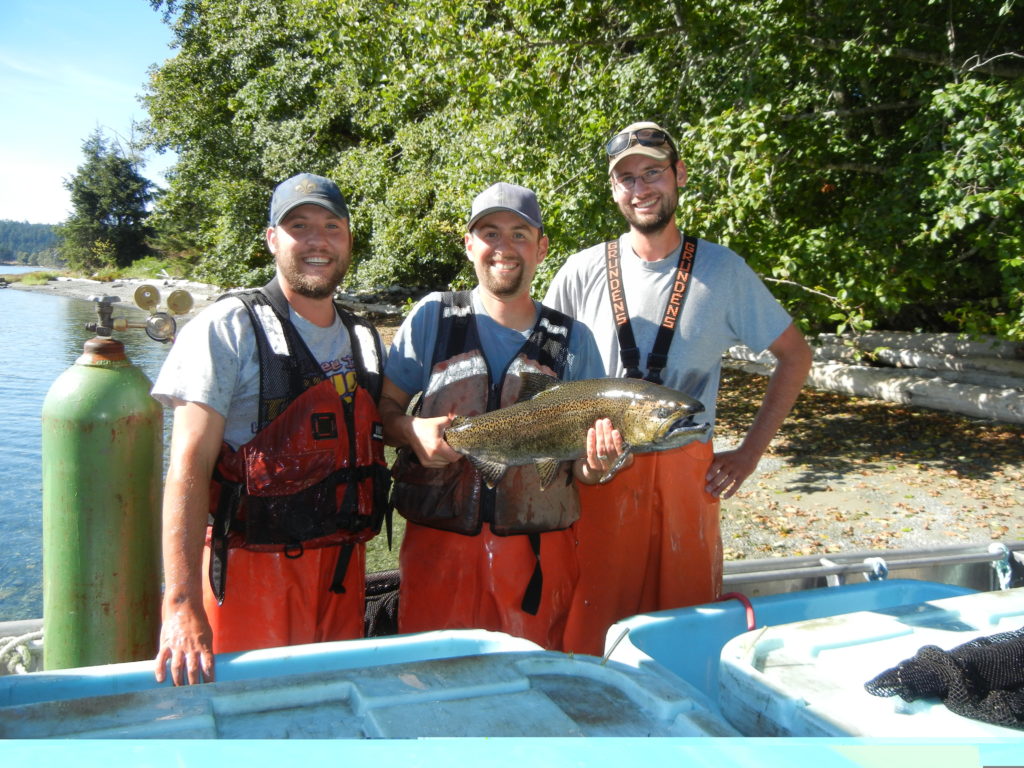
Yellow Island Aquaculture’s commitment to superior brood stock dates back to the inception of the company by two biologists, a zoologist and a geneticist, and the first farm manager who was a marine biologist and subsequently completed a PhD in fish genetics and is currently a professor at University of Windsor. Our abiding concern is the development of superior brood fish with minimal impact on the surrounding environment and totally eliminating impact on the wild fish. To achieve this we have focused on the local micro-adaptations which are a major characteristic of the native Pacific salmon species.
Yellow Island obtained its first stock from surplus eggs from the DFO facility at Robertson Creek, a local federal government hatchery on Vancouver Island. We subsequently acquired gametes from commercial facilities that had produced sex reversed mono males so that we could rear exclusively female stock. This stock originated from another local hatchery, Big Qualicum, on Vancouver Island. Thus our stock is completely locally derived.
We have relied entirely on in-house brood stock for the last 28 years with no further stock being introduced from the wild or other domesticated lines. We believe that in-house broodstock programs take maximum advantage of the micro-adaptability of the Pacific salmon. We also believe that the local indigenous species offer better potential for integration into the environment and superior performance over time while minimizing the impact on the wild stocks and the environment.
We have extensively researched and implemented biological containment programs using naturally produced triploid fish which are sterile and have no potential to interbreed with wild fish.
Our research commitment to the development of superior aquaculture strains of the indigenous Pacific salmon species long-term was necessitated by the fact that Chinook salmon are semelparous and breed only once from 3 to 5 years of age. Our broodstock program includes the following elements among others which have been implemented over the past 30 years.
Of more significance to the community at large and to the indigenous salmon population is that triploids are sterile. These animals not only cannot breed with the indigenous population of salmon but they do not mature and this means they do not ascend to the breeding grounds and disrupt spawning by competing with the indigenous salmon. This latter characteristic has led the Alaska Department of Fish & Game to mandate 99% to 100% triploidy in any stocks which are introduced into water containing native salmon and trout species.
Triploids have not achieved a large penetration in the aquaculture industry because it is a relatively difficult technique to master and because there are early losses and there is a perception of reduced performance in grow out stock over their lifetime.
Triploids are animals which have three sets of chromosomes instead of the normal two sets. This condition is not uncommon in nature as a result of a glitch in the extrusion of one set of chromosomes which is carried along by the egg at the time of fertilization. Some specific natural conditions such as the water pressure where fertilization takes place and the temperature of the water can increase the frequency of this occurrence.
Although the actual process of triploidy occurs relatively infrequently in nature the condition is not that commonly seen in mature animals for two reasons. First of all there is early mortality associated with the process and secondly the animals cannot reproduce because they are sterile. This results in fairly rapid elimination of individuals who are triploid or polyploid.
Polyploidy (multiple sets of chromosomes) is a relatively common occurrence in nature and has been selected for in a number of species. Bananas are triploid, oysters are tetraploid and wheat is hexaploid. Triploidy is regularly found in the wild salmon when looked for and the larger the fish the more likely it is to be triploid as these animals simply swim around and get bigger unless they are eaten.
Yellow Island’s research program has produced a method which reliably produces 100% triploidy measured by scientific methods and by keeping the animals until full maturity and observing that none of the triploid stock ever mature. The cost of doing this is that the mortality rates in the hatchery are variable and on average significantly elevated above those of diploid stocks and that there appears to be a spike in mortality of the fish that occurs in their second summer which increases the feed conversion ratio overall. Notwithstanding, the triploid fish are indistinguishable from diploid fish on morphological grounds except that they do not develop gonads. The flesh is identical. They look the same and they taste the same.
Triploidy can be induced either by genetic modification or by using chemicals but neither of these processes is employed by Yellow Island either in production or in research. The company uses only naturally occurring methods of heat and pressure shock to produce its triploid stock. In the unlikely event of an escapement the wild population would be 100% protected from any potential of interaction with our stocks.
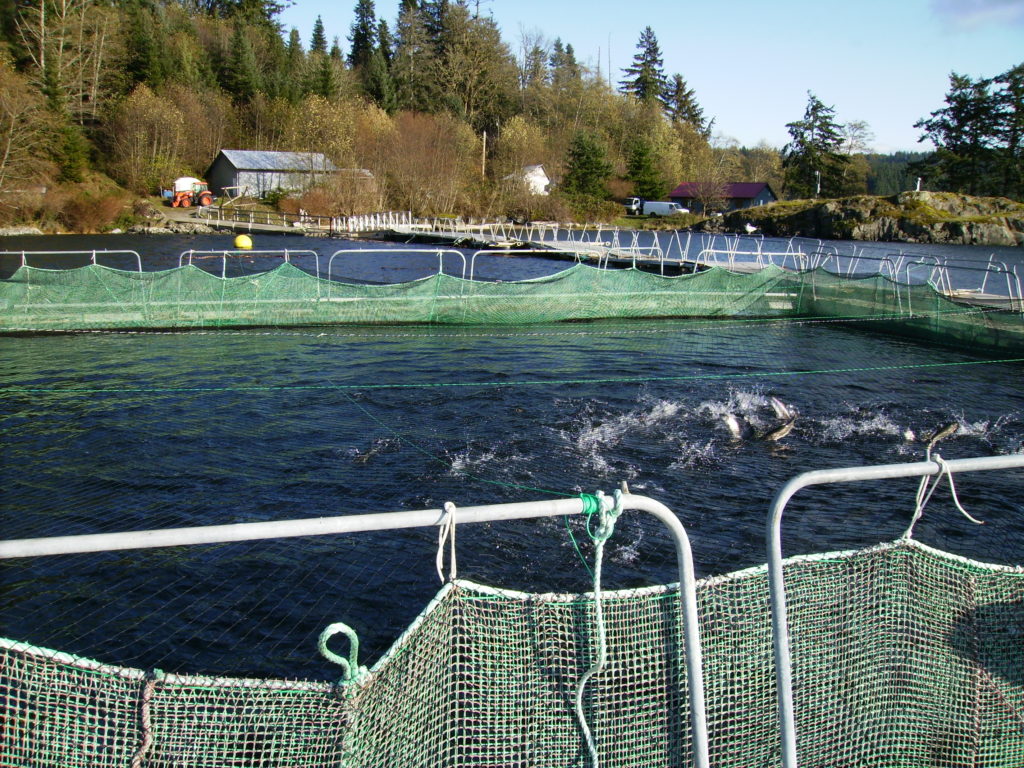
Containment nets are smaller than industry standards. Nets are all double enclosure and are monitored weekly year round.
In the event of an escapement the small net pen size coupled with the low stocking densities that we follow as part of our organic rearing program would mean that there would only be escapement of a very small number of fish. Again this contrasts with larger operations where up to 50,000 fish may escape in a single event.
All containment nets are checked weekly by a contract dive service. Any mortalities are recorded and examined for potential infectious causes and the carcasses are disposed of in an environmentally responsible manner through on-site composting or are rendered for fertilizer.
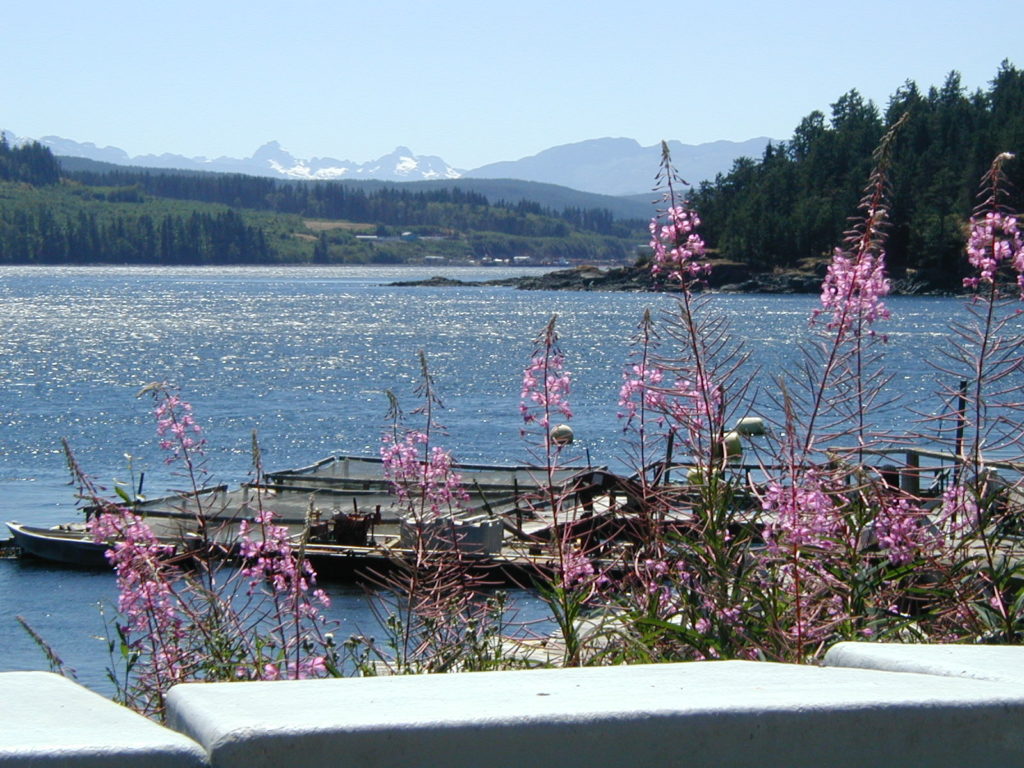
No algae blooms have occurred at our site for 30 years as a result of low ocean water temperatures, high water flows and mixing of deep water due to local natural up-wellings and currents.
They require extremely expensive mitigation measurements including as such as encasing the entire cage in an impenetrable membrane to exclude the blooms in this manner. Water needs to be introduced to the enclosure from deep down in the adjacent to the water column. High-powered air compressors can also be placed underneath the pen and bubbles of air will then create an airlift and bring algae-free deep water from deep beneath the pens up into the containment unit where the fish are.
During the course of any of these treatments or during the course of any significant algae bloom feeding needs to be stopped and fish husbandry and handling methods have to be curtailed accordingly. The cost to the operator and the potential loss of significant periods of growth are major setbacks.
The conditions which resulted in the blooms depend on water temperature and availability of light. The light parameter means that algae blooms cannot occur where surface light does not penetrate. This is the rationale for introducing deep water to the pens. Our Yellow Island site is immediately adjacent to Seymour Narrows. Less than a kilometer south or north into Discovery Passage the water depth is between 800 and a thousand feet and in Seymour Narrows itself the depth is 85 feet at a minimum. Massive up-wellings make Seymour Narrows a major hazard to navigation, but from the viewpoint of our adjacent fish farm, it provides a surfeit of deep, cold, nutrient rich water which is entirely algae bloom free even in the warmest months of the year.
Our Yellow Island site has never experienced an algae bloom in over 30 years of continuous operation nor have we detected significant concentrations of toxic algae by routine monitoring. We also have never been obliged to reduce our normal husbandry practices due to an algae bloom. No expensive or potentially stressful mitigation measures have been required at our site.
Our native Pacific Chinook salmon are naturally resistant to sea lice. No treatment has been necessary in 30 years on site. Routine lice counts over the last 12 years have shown less than 1 louse per fish in over 3000 fish checked at all stages of life.
Yellow Island organic standards designate that our fish are reared to a maximum density of 5 kilograms per cubic meter of sea water which has been shown to be the maximum density at which wild salmon school. For most of their life our salmon live in much lower densities also mimicking the wild situation.
Yellow Island research has conducted an evaluation of rearing densities in our hatchery facility under controlled environmental conditions. We have found that when the conditions are carefully controlled the animal behavior and stress hormone measurements do not show evidence of significant animal stress in densities as high as 50 kg/m³. The data are not yet generalizable to the more complex and more variable salt water marine environment.
An illustration of the comparative densities that has some visual appeal is to imagine a common bathtub which has a volume of approximately one half of a cubic meter of water. If one imagines this bathtub containing five 1 pound trout swimming around in it, that would give you an idea of what the density would look like at 5 kg/m³. Now imagine that same bathtub with fifty 1 pound trout swimming around in it and it will give you an idea of what 50 kg/m³ would look like in a net cage. One can point out that even at 50 kg/m³ it still can be correctly stated that the net cage is 95% water and only 5% fish.
We use double enclosures and tightly laced top nets to exclude predators.
Yellow Island uses a double total containment system in order to exclude predators. This means that in addition to the containment net for the fish, the entire farm site is enclosed in a robust predator control net around the outside. This net is complete and is checked regularly by the divers for integrity. The material is robust and is generally able to exclude all large predators.
Mesh size has to be carefully selected and maintained in order to avoid entrapment of birds and other small animals. Tightly sewn net covers on the pens are used to exclude birds and also to exclude otters and mink. The smaller fish require extremely small mesh top nets as the mink get through any larger mesh nets. The size of the top net can be increased as the fish get larger and are less susceptible to predation.
Yellow Island is committed to humane harvest and methods which maintain the highest quality products for extended shelf life and for the enjoyment for our customers of our superb product.
The options for humane harvesting farmed fish are also somewhat limited. The use of anaesthetics is prohibited in fish for human consumption. The most effective anesthetic agent that is available would be clove oil which is prohibited for use in fish for human consumption although apparently quite legal for direct human consumption or for use in aromatherapy in humans.
The harvesting of farmed fish necessitates that the fish should be crowded for efficient and timely capture. At Yellow Island this is accomplished by using a dark-colored seine net to crowd the fish. The animals are not crowded to stress levels and are then brailed out in a 500 L brail. The animals are in water throughout this time. The fish are transferred to a dewatering table and from there into a stun tank. Yellow Island uses carbon dioxide saturation as the method of choice for stunning. We have extensive experience with this technique and in our hands there is neither excessive agitation of the animals nor is there any significant variation in the degree of anaesthesia. Once the animals are insensible they are bled and transferred to an ice water bleeding tank from which they are transferred into slush ice for transfer to the processing plant.
Carbon dioxide anesthesia has been stigmatized as suffocation but there is actually no correspondence of CO2 narcosis and suffocation. The animals are provided with fully saturated oxygenated water at all times and the pH of the bath is maintained at about 6.5. These conditions are essential in order to avoid the agitation which people have described in CO2 anesthesia in the past. The major drawback to CO2 anesthesia in commercial fish processing is that the induction times are slow. We experience induction times of 3 to 5 minutes which means that in order to ensure that all animals are insensible, the batch of fish cannot be processed until five minutes after the last wet braille of fish has been introduced. This naturally slows the process down somewhat. While it is not suitable for large-scale commercial operations for this reason it is ideal for small operations which focus particularly on animal welfare such as our own.
The proper control of the temperature of the process is critical. It was earlier considered to be ideal to super chill the stunning bath but this produces undue agitation and the fish at Yellow Island are now stunned in the stun tank at the identical temperature to the seawater from which they are removed. Chilling below the 8° seawater level begins as soon as they enter the bleeding bath with ice. From that point onwards the animals are never above the 0° temperature.
The product is processed mainly at Walcan Seafoods which is within 5 km of the Yellow Island site and is available by road or by boat. Walcan is a large government certified world-class processing facility. We routinely receive accolades from all of the people processing the fish at Walcan about the quality of our product and the ease of handling because of the care we take at the time of harvest.
We also process fish at Campbell River Seafoods in Campbell River and we have done so for the entire 30 years that the company has been in operation. This is a small family run operation which is fully government certified and offers a range of services particularly to small customers which is hard to duplicate. They do custom smoking of our product which we shipped throughout Canada.
Through our research and our experience we are continually evaluating new ways to make the process more efficient and less traumatic to the animals. We are currently involved in a study with animal behaviorists from the University of Windsor looking at several aspects of the handling and harvest procedures to develop effective methods of assessing animal distress and to develop ways to mitigate this.
Scientific validation forms the core of our long term vision for sustainable aquaculture at Yellow Island Aquaculture. We recognize that all elements of our environment are interlinked to form the ecosystem as a functioning whole. Thirty years of production of superb salmon with no significant alteration in the surrounding environment attests to our commitment to sustainable fish husbandry.